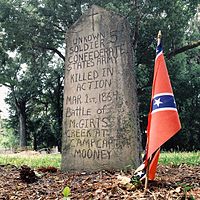| Skirmish at Cedar Creek | |||||||
|---|---|---|---|---|---|---|---|
| Part of the American Civil War | |||||||
 Camp Captain Mooney Cemetery | |||||||
| |||||||
| Belligerents | |||||||
|
|
| ||||||
| Commanders and leaders | |||||||
| lieutenant Colonel Benjamin B. Sample | |||||||
| Casualties and losses | |||||||
|
10(2 killed 3 wounded 5 captured) |
25(7 killed 12 wounded 6 captured/missing) | ||||||
The Skirmish at Cedar Creek, also known as Camp Mooney or McGirt's Creek, was a small engagement of the American Civil War fought in present-day Jacksonville, Florida on March 1, 1864. It was fought between a small Confederate States Army outpost and the 40th Massachusetts Volunteer Infantry of the Union Army, and resulted in 35 casualties. It was the last engagement in the Olustee Campaign.
Background
Jacksonville, Florida was occupied on and off by the Union throughout the Civil War. In February 1864 Union forces under General Truman Seymour went west out of Jacksonville to take back Florida for the Union and to recruit slaves for the Union Army. Confederate forces met the Union forces and defeated them at the Battle of Olustee near Lake City, Florida on February 20. After the battle Confederate forces were west of Jacksonville discouraging Union forces to venture out beyond their established lines. Lieutenant Colonel Benjamin B. Sample, the young confederate officer who had seen some of the worst fighting at Olustee, was ordered to deter any advance from Jacksonville.
Battle
On the morning of March 1, 1864 a portion of the 2nd Florida Cavalry went east toward Jacksonville to probe defenses. On that same day an expedition of a Union cavalry of the 40th Massachusetts left Camp Mooney and went west to probe the Confederate position. The Union expedition consisted of companies B, C, and D of 1st Massachusetts Cavalry, a squadron of Massachusetts infantry and one gun of Elders Horse Artillery under Major Stevens. At mid-morning the 2nd Florida Cavalry met the Union forces about 2 miles west of Camp Finegan. The Confederate forces were then joined by reinforcements and pushed the Union forces back through Camp Finegan.

At Cedar Creek the Union forces made a stand. The creek offered a natural barrier that hampered the Confederate advance. Because of the difficulty of the approach, Lieutenant Colonel Benjamin Sample ordered his force towards the creek in a piecemeal manner. An intense but short fight erupted between the two armies at the creek but the Union was forced out to Three Mile Run or McCoys Creek. The Confederates followed but the Union rear guard ambushed them killing Captain Winston Stephens and a private. The Confederate infantry managed to cross Cedar Creek and advanced toward Jacksonville. The Union forces met reinforcements from Camp Mooney and were ordered back to Cedar Creek but retreated again to their defense breastworks at Three Mile Run. At the end of the day 7 Confederates were killed, 12 wounded, 2 Union killed, 3 wounded and 5 captured. Confederates stayed in the area and guarded it from more Union encroachments while the Union held Jacksonville for the remainder of the war.
Camp Captain Mooney Cemetery
Camp Captain Mooney Cemetery was established on the same day of the battle. The cemetery is named after the Camp Captain Mooney outpost in the vicinity of where the battle occurred. The camp name comes from George Mooney (Builder of the Confederate Gun Boat in Jacksonville, on whose land it was located. It is owned by the United Daughters of the Confederacy.
Notes
- ^ Filzen, Lydia Colee. "The Battle of Cedar Creek". museumsouthernhistory.com. Museum of Southern History. Archived from the original on October 7, 2014. Retrieved September 25, 2014.
- Strickland, Sandy. "Marker lets people stand at Civil War battle site". Jacksonville.com. Florida Times-Union. Retrieved September 25, 2014.
- Frady, Tina. "CAPT. MOONEY CEMETERY or CAMP CAPT. MOONEY CEMETERY or ELLIS ROAD CEMETERY". Jaxgen.home.comcast.net. Jacksonville Genealogical Society, Inc. Archived from the original on September 30, 2015. Retrieved September 25, 2014.
- Florida Public Archaeology Network. "Camp Captain Mooney Cemetery". flpublicarchaeology.org. Florida Public Archaeology Network. Retrieved September 25, 2014.
References
30°19′15″N 81°46′43″W / 30.3208°N 81.7786°W / 30.3208; -81.7786
Categories: